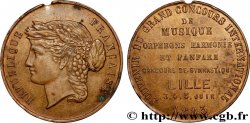E-auction 636-637565 - fme_1032957 - TERZA REPUBBLICA FRANCESE Médaille, Grand concours international de musique
Devi Sign-in ed essere un offerente approvato fare un'offerta, Login per fare offerte. Conti sono soggetti ad approvazione e di approvazione sono raggiunti entro 48 ore. Non aspettare fino al giorno di una vendita si chiude per registrarti.Confermando la tua offerta su questo oggetto ti impegni ad un contratto legalmente vincolante per l'acquisto di questo prodotto e fare clic su «offerta» costituisce accettazione dei termini di utilizzo de e-auctions cgb.fr.
Offerta deve essere collocato in euro gli importi interi vendita only.The si chiuderà al momento sulla descrizione dell'oggetto, eventuali offerte pervenute al sito dopo l'orario di chiusura non verranno eseguite. Volte transmition possono variare e le offerte potrebbero essere respinto se si attende per gli ultimi secondi. Per ulteriori informazioni ckeck le FAQ.
SENZA COSTI PER GLI ACQUIRENTI.
SENZA COSTI PER GLI ACQUIRENTI.
| Valutazione : | 10 € |
| Prezzo : | 2 € |
| Offerta maxima : | 12 € |
| Data di fine vendita : | 23 giugno 2025 20:27:00 |
| partecipanti : | 2 partecipanti |
Tipo : Médaille, Grand concours international de musique
Data: 1883
Nome della officina / città: 59 - Lille
Metallo : ottone
Diametro : 29 mm
Asse di coniazione : 12 h.
Peso : 6,88 g.
Orlo : lisse
Marchio : sans poinçon
Commenti sullo stato di conservazione:
Patine hétérogène avec des traces d’usure, quelques coups et rayures. Taches d’oxydation et traces d’une ancienne bélière
Diritto
Titolatura diritto : RÉPUBLIQUE - FRANÇAISE.
Descrittivo diritto : Tête de Marianne à gauche, une couronne de lauriers, de chêne et raisin dans les cheveux.
Rovescio
Titolatura rovescio : SOUVENIR DU GRAND CONCOURS INTERNATIONAL // DE / MUSIQUE / ORPHEONS HARMONIE / ET FANFARES / CONCOURS DE GYMNASTIQUE / LILLE / 3. 4. 5. JUIN / 1883.
Descrittivo rovescio : Légende circulaire et en 8 lignes.
Commento
Fondé par Wilhem en 1833, le mouvement des orphéons, appelés également Sociétés chorales ou Sociétés orphéoniques, était un mouvement festif et musical de masses. Il rassemblait, en France, puis aussi dans d'autres pays, des milliers de chorales masculines le plus souvent subventionnées par des entreprises ou des municipalités. Elles étaient constituées de chanteurs issus des classes moyennes ou populaires. Par la suite, des femmes purent également y participer.
Quantité de grands concerts et défilés furent organisés. Ils pouvaient rassembler jusqu'à des milliers de choristes devant des dizaines de milliers d'auditeurs.
Largement oublié en France, sauf au pays basque et dans le sud-ouest, ce mouvement est toujours très important en Catalogne.
Founded by Wilhelm in 1833, the orphéon movement, also called Choral Societies or Orphéonic Societies, was a festive and musical mass movement. In France, and later in other countries, it brought together thousands of male choirs, most often subsidized by businesses or municipalities. They were made up of singers from the middle or working classes. Later, women were also able to participate. Many large concerts and parades were organized. They could bring together up to thousands of choristers in front of tens of thousands of listeners. Largely forgotten in France, except in the Basque Country and the southwest, this movement is still very important in Catalonia.
Quantité de grands concerts et défilés furent organisés. Ils pouvaient rassembler jusqu'à des milliers de choristes devant des dizaines de milliers d'auditeurs.
Largement oublié en France, sauf au pays basque et dans le sud-ouest, ce mouvement est toujours très important en Catalogne.
Founded by Wilhelm in 1833, the orphéon movement, also called Choral Societies or Orphéonic Societies, was a festive and musical mass movement. In France, and later in other countries, it brought together thousands of male choirs, most often subsidized by businesses or municipalities. They were made up of singers from the middle or working classes. Later, women were also able to participate. Many large concerts and parades were organized. They could bring together up to thousands of choristers in front of tens of thousands of listeners. Largely forgotten in France, except in the Basque Country and the southwest, this movement is still very important in Catalonia.








 Segnalare un errore
Segnalare un errore Stampate la pagina
Stampate la pagina Condividi mia selezione
Condividi mia selezione Fai una domanda
Fai una domanda Consegnare / vendere
Consegnare / vendere
 Descrittivo
Descrittivo













